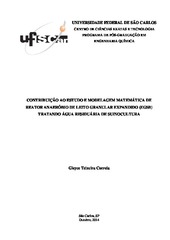| dc.contributor.author | Correia, Gleyce Teixeira | |
| dc.date.accessioned | 2016-06-02T19:55:41Z | |
| dc.date.available | 2014-11-20 | |
| dc.date.available | 2016-06-02T19:55:41Z | |
| dc.date.issued | 2014-10-03 | |
| dc.identifier.citation | CORREIA, Gleyce Teixeira. Contribution to the study and mathematical modelling of the expanded granular sludge bed (EGSB) reactor treating swine wastewater. 2014. 136 f. Tese (Doutorado em Ciências Exatas e da Terra) - Universidade Federal de São Carlos, São Carlos, 2014. | por |
| dc.identifier.uri | https://repositorio.ufscar.br/handle/ufscar/3957 | |
| dc.description.abstract | Anaerobic systems have been widely studied and used in treatment of wastewater from agriculture and others. Among the existing technologies, there are the EGSB (Expanded Granular Sludge Bed) reactors, which have emerged as improvement of UASB (Upflow Anaerobic Sludge Blanket) reactors. It was sought to evaluate the performance of an EGSB reactor using synthetic swine wastewater as substrate, increasing the volumetric organic load (2, 4, 8, 10 and 15 kgCOD.m-3.d-1) and the upflow velocity (6 and 10 m.h-1). Efficiencies higher than 83% were obtained in removal of COD, however there was a buildup of volatile acids and a possible microbial imbalance after the application of the load 10 kgDQO.m-3.d-1. The reactor showed homogeneity in microorganisms along the reactor, with the presence of bacilli of different sizes, coccus, and similar to the genera Methanosaeta and Methanosarcina. It was developed a mathematical model aiming to study in more detail the hydrodynamics of EGSB, generally regarded as continuous complete mix reactors (CSTR). For that, it was used a phenomenological model based on the mass balance of the reactor, and after the adjustment to the experimental data, it was observed that the EGSB reactor can be worked as a series of five continuous complete mix reactors (CSTR), three in the tube region and two in the separator region with kinetic intrinsic rate at approximately 7,5.10-5 L.mgSSV-1.h-1 and kinetic rate constant decreasing with increase in organic load. | eng |
| dc.description.sponsorship | Financiadora de Estudos e Projetos | |
| dc.format | application/pdf | por |
| dc.language | por | por |
| dc.publisher | Universidade Federal de São Carlos | por |
| dc.rights | Acesso Aberto | por |
| dc.subject | Biotecnologia | por |
| dc.subject | Tratamento anaeróbio | por |
| dc.subject | Efluentes de suinocultura | por |
| dc.subject | Modelagem matemática | por |
| dc.subject | Reator anaeróbio granular de leito expandido | por |
| dc.subject | Anaerobic treatment | eng |
| dc.subject | Swine wastewater | eng |
| dc.subject | Mathematical modelling | eng |
| dc.subject | EGSB reactor | eng |
| dc.title | Contribuição ao estudo e modelagem matemática de reator anaeróbio de leito granular expandido (EGSB) tratando água residuária de suinocultura | por |
| dc.title.alternative | Contribution to the study and mathematical modelling of the expanded granular sludge bed (EGSB) reactor treating swine wastewater | eng |
| dc.type | Tese | por |
| dc.contributor.advisor1 | Kwong, Wu Hong | |
| dc.contributor.advisor1Lattes | http://genos.cnpq.br:12010/dwlattes/owa/prc_imp_cv_int?f_cod=K4799459Z7 | por |
| dc.description.resumo | Sistemas anaeróbios vêm sendo muito estudados e utilizados no tratamento de efluentes agroindústrias, entre outros. Dentre as tecnologias existentes, têm-se os reatores EGSB (Expanded Granular Sludge Bed), que surgiram como aperfeiçoamento dos reatores UASB (Upflow Anaerobic Sludge Blanket). Buscou-se avaliar o desempenho de um reator EGSB utilizando água residuária sintética de suinocultura como substrato, aumentando a carga orgânica volumétrica (2, 4, 8, 10 e 15 kgDQO.m-3.d-1) e a velocidade ascensional (6 e 10 m.h-1). Foram obtidas eficiências superiores a 83% na remoção de DQO, porém ocorreu acúmulo de ácidos voláteis, e provável desequilíbrio microbiano após aplicação da carga de 10 kgDQO.m-3.d-1. O reator apresentou certa homogeneidade nos microrganismos presentes ao longo do reator, com presença de bacilos de diferentes dimensões, cocos, e microrganismos semelhantes aos gêneros Methanosaeta e Methanosarcina. Desenvolveu-se um modelo matemático buscando estudar de maneira mais detalhada a hidrodinâmica do EGSB, geralmente considerados como reatores contínuos de mistura completa (CSTR). Para isto, utilizou-se um modelo fenomenológico, baseado no balanço de massa do reator, e após ajuste aos dados experimentais, observou-se que o reator EGSB pode ser trabalhado como uma série de cinco reatores contínuos de mistura completa (CSTR), sendo três na região do tubo do EGSB e dois na região do separador, com constante cinética intrínseca de aproximadamente 7,5.10-5 L.mgSSV-1.h-1 e com constante cinética aparente diminuindo com o aumento da carga orgânica. | por |
| dc.publisher.country | BR | por |
| dc.publisher.initials | UFSCar | por |
| dc.publisher.program | Programa de Pós-Graduação em Engenharia Química - PPGEQ | por |
| dc.subject.cnpq | ENGENHARIAS::ENGENHARIA QUIMICA | por |
| dc.contributor.authorlattes | http://lattes.cnpq.br/8644937548157443 | por |
